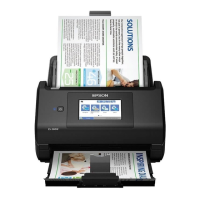1.
Access Web
Cong,
and then select the Network Security tab. Next, select SSL/TLS >
Certicate
or IPsec/IP
Filtering > Client Certicate or IEEE802.1X > Client Certicate.
2.
Click Delete.
3.
Conrm that you want to delete the certicate in the message displayed.
Related Information
& “Running Web Cong on a Web Browser” on page 26
Updating a Self-signed
Certicate
Because the Self-signed
Certicate
is issued by the scanner, you can update it when it has expired or when the
content described changes.
1.
Access Web Cong and select the Network Security tab > SSL/TLS > Certicate.
2.
Click Update.
3.
Enter Common Name.
You can enter up to 5 IPv4 addresses, IPv6 addresses, host names, FQDNs between 1 to 128 characters and
separating them with commas. e rst parameter is stored to the common name, and the others are stored to
the alias eld for the subject of the certicate.
Example:
Scanner's IP address : 192.0.2.123, Scanner name : EPSONA1B2C3
Common name : EPSONA1B2C3,EPSONA1B2C3.local,192.0.2.123
4.
Specify a validity period for the
certicate.
5.
Click Next.
A conrmation message is displayed.
6.
Click OK.
e scanner is updated.
Note:
You can check the
certicate
information from Network Security tab > SSL/TLS >
Certicate
> Self-signed
Certicate
and click Conrm.
Related Information
& “Running Web Cong on a Web Browser” on page 26
Conguring
a CA
Certicate
When you set the CA
Certicate
, you can validate the path to the CA
certicate
of the server that the scanner
accesses. is can prevent impersonation.
You can obtain the CA
Certicate
from the
Certication
Authority where the CA-signed
Certicate
is issued.
Administrator Information
>
Advanced Security Settings
>
Using a Digital Certicate
208

